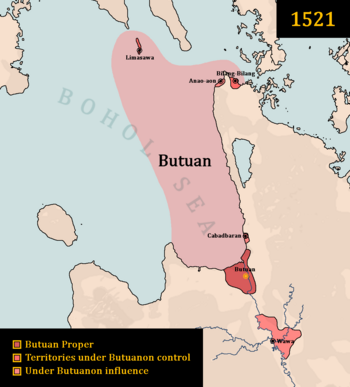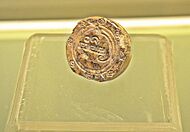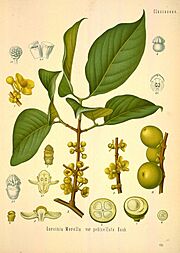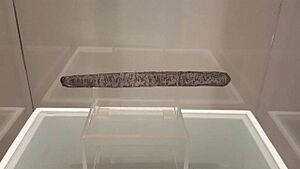Butuan (historical polity) facts for kids
Quick facts for kids
Ancient Butuan
But'ban |
|||||||||
|---|---|---|---|---|---|---|---|---|---|
| Before 1001–1597 | |||||||||

Map of the Rajahnate of Butuan in 1521, with Butuan proper (colored dark brown), its controlled territories (brown), and territories under its influence (light brown).
|
|||||||||
| Capital | Butuan | ||||||||
| Common languages | Butuanon, Old Malay, other Visayan languages | ||||||||
| Religion | Hinduism, Buddhism and animism | ||||||||
| Government | Monarchy | ||||||||
| History | |||||||||
|
• Established
|
Before 1001 | ||||||||
|
• First historical reference by Song dynasty records
|
1001 | ||||||||
|
• Blood compact with Ferdinand Magellan
|
31 March 1521 | ||||||||
|
• Christianization of the polity under Silongan
|
1567 | ||||||||
|
• Area conquered by Spain
|
8 September 1597 | ||||||||
| Currency | Piloncitos, barter rings | ||||||||
|
|||||||||
| Today part of | Philippines | ||||||||
Butuan, also known as the Rajahnate of Butuan or the Kingdom of Butuan, was an old kingdom in the northeastern part of Mindanao island. This area is now Butuan in the Philippines. Butuan was famous for its gold mining, beautiful gold jewelry, and a wide network of trade. It traded with many ancient civilizations across maritime Southeast Asia and beyond.
Over a long time, Butuan had direct trade links with powerful places like China, Champa, Đại Việt, Brunei, Srivijaya, Majapahit, the Khmer Empire, and even Persia. They also traded with areas that are now part of Thailand.
Many large outrigger boats, called balangay, have been found near the Libertad River. These boats have taught us a lot about Butuan's past. Because of these discoveries, Butuan is seen as a very important trading port in the Caraga region during ancient times.
Contents
What's in a Name?
The name Butuan likely existed long before the Spanish arrived in the Philippines. One idea comes from an old rhinoceros ivory seal. This seal has carvings in an ancient script from around the 10th century. A Dutch expert read it as "But-wan".
Another idea is that the name comes from the word batuan. This is a fruit similar to a mangosteen, which is common in Mindanao. Some also believe the name came from Datu Bantuan, who might have been an early leader of the area.
Butuan's Story: What Records Tell Us
Butuan and Ancient China
Butuan had contact with the Song dynasty of China as early as 1001 AD. Chinese records, like the Song Shih, mention Butuan sending a group to the Chinese Imperial Court on March 17, 1001 AD.
At that time, Butuan was a major center for gold mining and trade in northeastern Mindanao. It was known for making metal tools, weapons, musical instruments, and gold jewelry. Butuan was described as a kingdom where Hinduism was common and the rulers were Buddhist.
The chief, or "king," of Butuan named Kiling sent an envoy to China. He asked for his kingdom to be treated with the same respect as the envoy from Champa. A researcher named Eric Casino thinks the name Kiling might be Indian, referring to people from India. The Chinese court did not grant this request at first.
Later, a new ruler named Sri Bata Shaja managed to get equal diplomatic status with Champa. He sent a grand ambassador named Likanhsieh. Likanhsieh surprised the Chinese Emperor by presenting a message carved on a gold tablet. He also brought rare items like white dragon camphor and Moluccan cloves. This impressive display made China interested in Butuan.
Diplomatic relations between Butuan and China became very strong during the Yuan dynasty. However, in the 1300s, a Chinese record said that Brunei invaded or took control of Butuan, Sulu, and Ma-i (Mindoro). These kingdoms later regained their freedom.
Butuan and the Spanish
During the journey of Ferdinand Magellan, the first Catholic mass in the Philippines was held. This mass took place on March 31, 1521, on the island of Mazaua. Rajah Siagu, the ruler of Butuan at that time, was present along with Rajah Kolambu.
In 1596, Spanish Catholic missionaries, led by the Jesuits, arrived in Butuan. Their goal was to establish a Spanish presence in Mindanao. On September 8, 1597, the first church in Butuan was opened. This event marked the beginning of Spanish rule over Butuan. Later, the Augustinian Recollects took over from the Jesuits.
Amazing Discoveries

Many ancient jars have been found in the Butuan area. These jars show how wealthy the kingdom was and how it traded with different cultures. Some of these jars have been dated to specific periods:
- From Tambralinga (900–1100 AD)
- From Hariphunchai (800–900 AD)
- From Japan (12th to 16th centuries AD)
- From China's Song dynasty (1001–1271)
- From China's Yuan dynasty (1271–1368)
- From China's Ming dynasty (1368–1521)
- From the Khmer Empire (802–900 AD)
- From the Sukhothai Kingdom (1300–1400)
- From Champa (1000–1200)
- From Persia (9th to 10th centuries AD)
These artifacts were found near the Ambangan Archeological Site in Libertad. They prove that Butuan traded with India, Japan, Han Chinese, and other Southeast Asian countries during these times.
Who Ruled Butuan?
Here are some of the known rulers of Butuan:
| Ruler's Title | Important Events | From | Until |
|---|---|---|---|
| Kiling | Sent missions to China in 1003 and 1007 | 1001 | 1009 |
| Sri Bata Shaja | Sent the ambassador Likanhsieh to China | 1011 | ? |
| Rajah Siagu | Met Ferdinand Magellan and made a Blood Pact | ? | 1521 |
| Linampas | Son of Rajah Siagu | 1521 | 1567 |
| Silongan | Ruler of Butuan, converted to Christianity and was baptized as Felipe Silongan | 1567 | 1596 |
See Also
- Limasawa
- Agusan image
- Butuanon people
- Indian influences in early Philippine polities



